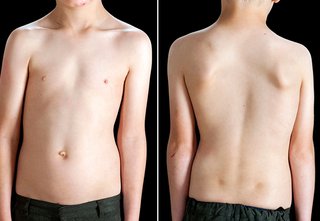What is scoliosis?
Scoliosis is a sideways curvature of the spine.
There are 4 main types of scoliosis:
- Idiopathic
- Degenerative
- Congenital
- Neurological
The signs of scoliosis include:
- A visibly curved spine
- Leaning to one side
- Uneven shoulders
- One shoulder or hip sticking out
- The ribs sticking out on one side
- Clothes not fitting well

Congenital
This is very rare, and occurs as the foetus develops in the womb. It is therefore diagnosed at birth.
Neurological
This can occur in people with neurological conditions such as cerebral palsy or muscular dystrophy, where the postural muscles around the spine are either tight or weak, and so a scoliosis can develop as the person grows.
Idiopathic
This is a more common type of scoliosis. It occurs as a child grows, and so usually becomes noticeable in adolescence. The cause is unknown, and there does not seem to be any link with diet, exercise or lifestyle, although it does sometimes run in families. Idiopathic scoliosis are often very mild, are pain free, and are often not noticed unless X-rayed. The angle of the scoliosis can change as the child grows, and if this becomes severe you should be referred to an orthopaedic consultant with the possibility of having surgery, as there can be risk of internal organs being affected.
Degenerative
This occurs over time, as our spinal joints and discs degenerate. This is part of the normal ageing process, much like getting grey hair or developing wrinkles. However, if the degenerative changes in our spine are more so on one side than the other, then that can cause a scoliosis to develop. This can cause balance difficulties if postural changes develop, and sometimes can be associated with pain as well. Research suggests degenerative scoliosis may be present in up to 60% of the population over 60 years of age, but there is no definite correlation between scoliosis and back pain.

What should I do if I have a scoliosis?
If you are an adolescent, you should seek advice from your GP – they may wish to monitor you or refer you to a specialist if the angle of the scoliosis is becoming severe.
If your scoliosis is degenerative and pain free, then you should continue with normal activities. It is not clear whether exercise improves scoliosis, but there is a lot of evidence to showing that exercise is very good for managing back pain, so if you have been diagnosed with a scoliosis, you should not avoid exercise, unless this has been advised by your doctor.
If you are of any age with either an idiopathic or degenerative scoliosis and experiencing pain, then either see your GP or book in to see a physiotherapist for an assessment. As a physiotherapist, I have seen many patients with scoliosis and co-existing back pain, and successfully helped them with managing their symptoms.
If you would like to book a physiotherapy appointment at Animated Physiotherapy please purchase a voucher via our shop and email [email protected] so we can get you booked in.
***
References:
Gordon, R & Bloxam, S (2016). A systematic review of the effects of exercise and physical activity on non-specific chronic low back pain. Healthcare (Basel, Switzerland), 4(2), pp. 22.
NHS. 2017. Overview Scoliosis. NHS. 27/11/19. <www.nhs.uk/conditions/scoliosis/>.
Schwab, F, et al (2005). Adult scoliosis: prevalence SF-36, and nutritional parameters in an elderly volunteer population. Spine, 30(9), pp. 1082-1085.
